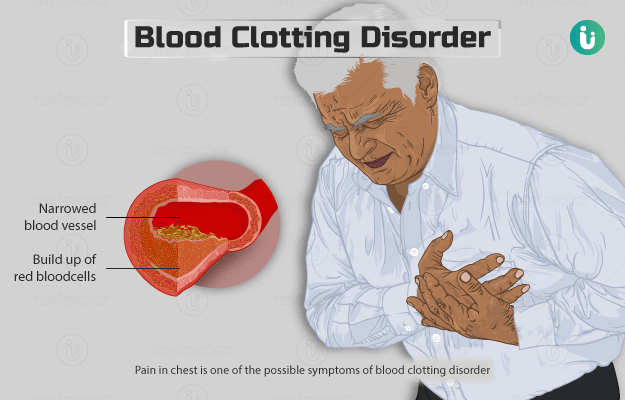What are blood clotting disorders?
Blood clotting disorders are conditions in which either bleeding continues for longer durations or the blood gets clogged up within the blood vessels. If bleeding continues for a longer duration within the internal organs or blood vessels, it can become a medical emergency.
What are its main signs and symptoms?
There are two main types of blood clotting disorders, bleeding disorders and clotting disorders, each type with their respective symptoms.
Signs and symptoms of bleeding disorders:
- Easy and excessive bleeding from small cuts.
- Easy development of bruises.
- Frequent epistaxis (bleeding from nose).
- Excessive menstrual bleeding.
- Passing of blood in urine or stool (passing black coloured stool).
- Bleeding into the joints without injury.
Signs and symptoms of clotting disorder:
Clotting disorders are also known as hypercoagulable states. In these conditions, a blood clot is formed in the veins, and this clot, due to pressure, is dislodged into the circulation. Once the blood clot goes into the circulation, it can get stuck in smaller blood vessels or capillaries causing their blockage; and symptoms develop depending upon which organ’s blood vessel is blocked.
Here are common symptoms of hypercoagulable states:
- Swelling of foot (calf and ankles)
- Painful cramps in the legs (claudication)
- Pain in the chest
- Difficulty in breathing
- Fast breathing (Read more: Shortness of breath causes)
- Low blood pressure
- Increased heart rate
What are its main causes?
Mechanism of blood clotting involves platelets, clotting factors, and proteins; thus, the causes of blood clotting disorders include abnormalities in any of these blood components. The most common causes of bleeding disorders include:
- Heredity – Common diseases are haemophilia, which is due to poor formation of clotting factors caused by a genetic mutation.
- Vitamin K deficiency – Diet deficient in vitamin K can cause bleeding issues.
- Liver disease or liver failure –Liver damage due to cirrhosis, hepatitis or fatty degeneration, can reduce the production of clotting factors and result in bleeding disorders.
- Drug-induced – Certain drugs like aspirin and warfarin are known to alter the mechanism of blood clotting and their prolonged use can result in clotting disorders.
Common causes of hypercoagulable states include:
- Cancer
- Chemotherapy agents like tamoxifen, thalidomide etc.
- Burns, trauma or surgery
- Pregnancy
- Obesity
How are they diagnosed and treated?
Usually, the medical history and a careful medical examination help in establishing the diagnosis of blood clotting disorders, yet certain blood tests are useful in determining the cause of these diseases. These include:
- Complete blood count – Low platelet levels can be indicative of clotting issues.
- Bleeding time & clotting time – Finding out bleeding and clotting time can help in identifying the type of issue (this test is obsolete now, as it is replaced by prothrombin time and activated partial thromboplastin time).
- Prothrombin time (PT) – Usually, it is calculated with internal normalized ratio (INR) levels which help in determining the blood clotting time.
- Activated partial thromboplastin time (aPTT) – This also helps in identifying clotting time.
- Certain other specific tests include Protein C activity, Protein S activity, Anti-thrombin activity etc.
Treatment of blood clotting disorder is based on the cause of the disease. Treatment can be cause-based, symptomatic
Certain medicines used for treatment include:
- Anti-platelet factors – Aspirin and clopidogrel, which reduce platelet aggregation and clotting.
- Anticoagulants – Warfarin, heparin, low molecular weight heparin (LMWH), and fondaparinux are the drugs that prevent blood coagulation and can help in treating hypercoagulable states.
- Vitamin K supplements – In case of vitamin K deficiency, supplementing with vitamin K is helpful.
- Blood transfusion or platelet transfusion – In case of platelet deficiency, transfusing blood platelets help in restoring bleeding issues.
- Factor replacement therapy – Helpful in treating haemophilia.

 OTC Medicines for Blood Clotting Disorders
OTC Medicines for Blood Clotting Disorders















